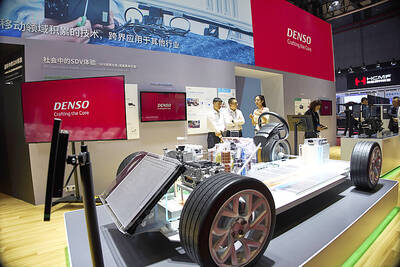Integrated Digital Technologies Inc (劍揚光學) said yesterday that it will start mass production of embedded solar cells in liquid-crystal-display (LCD) panels by the end of this year because of the increased popularity of panels known as interactive screens (iScreen).
The company said it would ship 5 million units of iScreen panels by next year, grabbing a global market share of 20 percent, Naejye Hwang (黃乃傑), Integrated Digital’s display division director, told a press conference.
“Unlike other touch screen panels that have extra film or glass with photo sensors on top of the regular LCD panel, Integrated Digital embeds solar cells in the thin-film-transistor [TFT] array layer during the panel-making process, thereby reducing the weight and thickness of the final product,” Hwang said.
This can save up to 30 percent of manufacturing costs because it reduces the need for additional film or glass components as well as additional labor, company founder and chief executive officer Hwang Huey-liang (黃惠良) said.
The company said the iScreen could be used on PCs, while its applications ranged from gaming, interactive Excel, Picasa, Google Earth as well as AtutoCAD and other drawing software. It said iScreens use less power and have an extended lifetime and unique remote control and writing capabilities.
The company will display its technology at Computex Taipei, which opens on Tuesday and closes on June 6 at Taipei World Trade Center Exhibition Hall I.
Meanwhile, VMAX Telecom Co (威邁思電信) will provide high-speed wireless Internet service on the MRT Muzha Line as part of its program for Computex Taipei.
It said WiMAX would be the main theme of this year’s show, using the slogan: “WiMAX on the Move.”
“There will be a more diverse display of [WiMAX] products and many are equipped with built-in WiMAX chips,” said Enoch Du (杜全昌), secretary-general of the Taipei Computer Association (TCA, 台北市電腦公會).
“This year, the entire [WiMAX] industry is expected to reach a growth rate of 50 percent and the output value will exceed NT$10 billion by the end of this year,” Du said.
Michael Chen (陳武宏), director of Intel Asia-Pacific Embedded Sales Group, said WiMAX has proved to be an economic and efficient broadband network.
Intel projected that the number of WiMAX subscribers worldwide could nearly double to 800 million by the end of next year, from 430 million at present, Chen said.
On April 27, Tatung InfoComm Co (大同電信) became the first company in Taiwan to launch its WiMAX service in Penghu.
Five more WiMAX operators are expected to launch commercial services in the second half of this year, Du said.

GROWING OWINGS: While Luxembourg and China swapped the top three spots, the US continued to be the largest exposure for Taiwan for the 41st consecutive quarter The US remained the largest debtor nation to Taiwan’s banking sector for the 41st consecutive quarter at the end of September, after local banks’ exposure to the US market rose more than 2 percent from three months earlier, the central bank said. Exposure to the US increased to US$198.896 billion, up US$4.026 billion, or 2.07 percent, from US$194.87 billion in the previous quarter, data released by the central bank showed on Friday. Of the increase, about US$1.4 billion came from banks’ investments in securitized products and interbank loans in the US, while another US$2.6 billion stemmed from trust assets, including mutual funds,

AI TALENT: No financial details were released about the deal, in which top Groq executives, including its CEO, would join Nvidia to help advance the technology Nvidia Corp has agreed to a licensing deal with artificial intelligence (AI) start-up Groq, furthering its investments in companies connected to the AI boom and gaining the right to add a new type of technology to its products. The world’s largest publicly traded company has paid for the right to use Groq’s technology and is to integrate its chip design into future products. Some of the start-up’s executives are leaving to join Nvidia to help with that effort, the companies said. Groq would continue as an independent company with a new chief executive, it said on Wednesday in a post on its Web

JOINT EFFORTS: MediaTek would partner with Denso to develop custom chips to support the car-part specialist company’s driver-assist systems in an expanding market MediaTek Inc (聯發科), the world’s largest mobile phone chip designer, yesterday said it is working closely with Japan’s Denso Corp to build a custom automotive system-on-chip (SoC) solution tailored for advanced driver-assistance systems and cockpit systems, adding another customer to its new application-specific IC (ASIC) business. This effort merges Denso’s automotive-grade safety expertise and deep vehicle integration with MediaTek’s technologies cultivated through the development of Media- Tek’s Dimensity AX, leveraging efficient, high-performance SoCs and artificial intelligence (AI) capabilities to offer a scalable, production-ready platform for next-generation driver assistance, the company said in a statement yesterday. “Through this collaboration, we are bringing two

Even as the US is embarked on a bitter rivalry with China over the deployment of artificial intelligence (AI), Chinese technology is quietly making inroads into the US market. Despite considerable geopolitical tensions, Chinese open-source AI models are winning over a growing number of programmers and companies in the US. These are different from the closed generative AI models that have become household names — ChatGPT-maker OpenAI or Google’s Gemini — whose inner workings are fiercely protected. In contrast, “open” models offered by many Chinese rivals, from Alibaba (阿里巴巴) to DeepSeek (深度求索), allow programmers to customize parts of the software to suit their